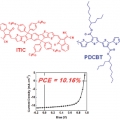
Probing Distinct Fullerene Formation Processes from Carbon Precursors of Different Sizes and Structures
| author | Hugh I Kim |
|---|---|
| Homepage | https://sites.google.com/site/hughkimgroup/ |
| journal | Anal. Chem. 2016, Article DOI: 10.1021/acs.analchem.6b02076 |
| Attachment '1' |
|---|
Fullerenes, cage-structured carbon allotropes, have been the subject of extensive research as new materials for diverse purposes. Yet, their formation process is still not clearly understood at the molecular level. In this study, we performed laser desorption ionization-ion mobility-mass spectrometry (LDI-IM-MS) of carbon substrates possessing different molecular sizes and structures to understand the formation process of fullerene. Our observations show that the formation process is strongly dependent on the size of the precursor used, with small precursors yielding small fullerenes and large graphitic precursors generally yielding larger fullerenes. These results clearly demonstrate that fullerene formation can proceed via both bottom-up and top-down processes, with the latter being favored for large precursors and more efficient at forming fullerenes. Furthermore, we observed that specific structures of carbon precursors could additionally affect the relative abundance of C60 fullerene. Overall, this study provides an advanced understanding of the mechanistic details underlying the formation processes of fullerene.

« Prev Programmed activation of cancer cell apoptosis: A tumor-targe...
 Programmed activation of cancer cell apoptosis: A tumor-targe...
2016.07.29by Manager
〈
Programmed activation of cancer cell apoptosis: A tumor-targe...
2016.07.29by Manager
〈
Manifesting Subtle Differences of Neutral Hydrophilic Guest I... Next »
 Manifesting Subtle Differences of Neutral Hydrophilic Guest I...
2016.07.29by Manager
〉
Manifesting Subtle Differences of Neutral Hydrophilic Guest I...
2016.07.29by Manager
〉
-
Read More

Highly Efficient Fullerene-Free Polymer Solar Cells Fabricated with Polythiophene Derivative
Han Young Woohttp://www.ooml.korea.ac.kr/A highly efficient fullerene-free polymer solar cell (PSC) based on PDCBT, a polythiophene derivative substituted with alkoxycarbonyl, has achieved an impressive power conversion efficiency of 10.16%, which is the best result in PSCs based o...Date2016.09.29 ByManager Views3657 -
Read More

Low-voltage organic devices based on pristine and self-assembled monolayer-treated HfTiOx gate dielectrics
Jong-Ho Choihttp://neslab.campushomepage.com/index2.aspLow-voltage organic field-effect transistors (OFETs) and complementary metal oxide semiconductor (CMOS) inverters based on pentacene and N,N′-ditridecylperylene-3,4,9,10-tetracarboxylic diimide (PTCDI-C13) were fabricated on HfTiOx gat...Date2016.09.20 ByManager Views1691 -
Read More

Higher Quantum State Transitions in Colloidal Quantum Dot with Heavy Electron Doping
Kwang Seob Jeonghttps://sites.google.com/site/ksjkulab/Electron occupation in the lowest quantized state of the conduction band (1Se) in the colloidal quantum dot leads to the intraband transition in steady-state (1Se-1Pe). The intraband transition, solely originating from the quantum confinemen...Date2016.09.20 ByManager Views3397 -
Read More

High-harmonic generation: Drive round the twist
Minhaeng Chohttp://cmsd.ibs.re.kr/html/cmsd_en/Light has long been used to detect the chirality of molecules but high-order harmonic generation now provides access to these chiral interactions on ultrafast timescales. http://www.nature.com/nphys/journal/v11/n8/full/nphys3395.htmlDate2016.09.20 ByManager Views1771 -
Read More

Gradients of Rectification: Tuning Molecular Electronic Devices by the Controlled Use of Different-Sized Diluents in Heterogeneous Self-Assembled Monolayers
Hyo Jae YoonMolecular electronics has received significant attention in the last decades. To hone performance of devices, eliminating structural defects in molecular components inside devices is usually needed. We herein demonstrate this problem can be ...Date2016.07.29 ByManager Views1956 -
Read More

Investigation of Charge Carrier Behavior in High Performance Ternary Blend Polymer Solar Cells
Han Young Woohttp://www.ooml.korea.ac.kr/This study demonstrates high-performance, ternary-blend polymer solar cells by modifying a binary blend bulk heterojunction (PPDT2FBT:PC71BM) with the addition of a ternary component, PPDT2CNBT. PPDT2CNBT is designed to have complementary ab...Date2016.07.29 ByManager Views1838 -
Read More

Adsorption of Carbon Dioxide on Unsaturated Metal Sites in M2(dobpdc) Frameworks with Exceptional Structural Stability and Relation between Lewis Acidity and Adsorption Enthalpy
Chang Seop Honghttp://immlab.korea.ac.kr/A series of metal–organic frameworks (MOFs) M2(dobpdc) (M=Mn, Co, Ni, Zn; H4dobpdc=4,4′-dihydroxy-1,1′-biphenyl-3,3′-dicarboxylic acid), with a highly dense arrangement of open metal sites along hexagonal channels wer...Date2016.07.29 ByManager Views5634 -
Read More

Programmed activation of cancer cell apoptosis: A tumor-targeted phototherapeutic topoisomerase I inhibitor
Jong Seung Kimhttp://orgchem.korea.ac.kr/index2.aspWe report here a tumor-targeting masked phototherapeutic agent 1 (PT-1). This system contains SN-38—a prodrug of the topoisomerase I inhibitor irinotecan. Topoisomerase I is a vital enzyme that controls DNA topology during replication,...Date2016.07.29 ByManager Views12969 -
Read More

Probing Distinct Fullerene Formation Processes from Carbon Precursors of Different Sizes and Structures
Hugh I Kimhttps://sites.google.com/site/hughkimgroup/Fullerenes, cage-structured carbon allotropes, have been the subject of extensive research as new materials for diverse purposes. Yet, their formation process is still not clearly understood at the molecular level. In this study, we performe...Date2016.07.29 ByManager Views3884 -
Read More

Manifesting Subtle Differences of Neutral Hydrophilic Guest Isomers in a Molecular Container by Phase Transfer
Hugh I. Kimhttps://sites.google.com/site/hughkimgroup/Achieving strong host–guest interactions between synthetic hosts and hydrophilic guests in solution is challenging because solvation effects overwhelm other effects. To resolve this issue, we transferred complexes of cucurbit[7]uril (C...Date2016.07.29 ByManager Views1638
Designed by sketchbooks.co.kr / sketchbook5 board skin